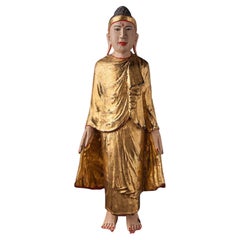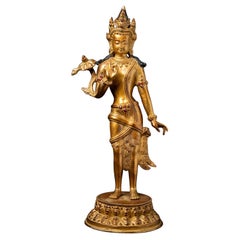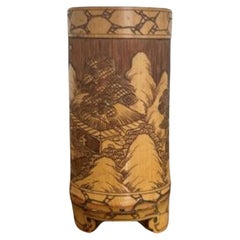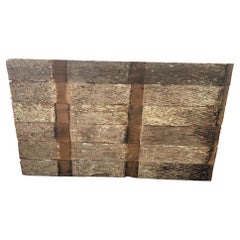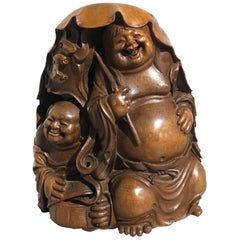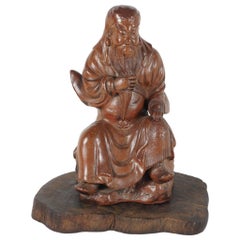Sculptures and Carvings
19th Century Burmese Antique Sculptures and Carvings
Wood
Mid-20th Century Nepalese Sculptures and Carvings
Bronze
Early 20th Century Chinese Sculptures and Carvings
Wood
Early 1900s Primitive Antique Sculptures and Carvings
Wood, Reclaimed Wood
19th Century Chinese Qing Antique Sculptures and Carvings
Bamboo
Late 19th Century Chinese Qing Antique Sculptures and Carvings
Terracotta, Wood
Early 20th Century Indian Rustic Sculptures and Carvings
Wood
1970s Indonesian Vintage Sculptures and Carvings
Wood
1980s Chinese Chinese Export Vintage Sculptures and Carvings
Wood
Mid-20th Century Nepalese Sculptures and Carvings
Bronze
Mid-20th Century Chinese Qing Sculptures and Carvings
Soapstone
Mid-20th Century Japanese Folk Art Sculptures and Carvings
Wood, Hardwood
1960s Thai Vintage Sculptures and Carvings
Laminate, Lacquer
Mid-19th Century Burmese Other Antique Sculptures and Carvings
Marble
19th Century Burmese Antique Sculptures and Carvings
Lacquer
15th Century and Earlier Indian Antique Sculptures and Carvings
Bronze
17th Century Burmese Antique Sculptures and Carvings
Marble
19th Century Burmese Antique Sculptures and Carvings
Wood
17th Century Chinese Ming Antique Sculptures and Carvings
Stone
19th Century Burmese Antique Sculptures and Carvings
Wood
19th Century Tibetan Other Antique Sculptures and Carvings
Bronze
Early 20th Century French Sculptures and Carvings
Bronze
Early 19th Century Victorian Antique Sculptures and Carvings
Bronze
Mid-20th Century Indonesian Other Sculptures and Carvings
Wood
19th Century Indian Antique Sculptures and Carvings
Wood
Mid-19th Century Chinese Qing Antique Sculptures and Carvings
Wood
1830s Thai Other Antique Sculptures and Carvings
Wood
15th Century and Earlier Cambodian Antique Sculptures and Carvings
Bronze
20th Century Japanese Showa Sculptures and Carvings
Wood
Late 19th Century Chinese Chinese Export Antique Sculptures and Carvings
Wood
18th Century Burmese Antique Sculptures and Carvings
Wood
15th Century and Earlier Afghan Adam Style Antique Sculptures and Carvings
Crystal
19th Century Thai Antique Sculptures and Carvings
Bronze, Gold Leaf
Late 19th Century Chinese Antique Sculptures and Carvings
Elm
Mid-17th Century Japanese Edo Antique Sculptures and Carvings
Wood
16th Century Burmese Antique Sculptures and Carvings
Marble
20th Century French Sculptures and Carvings
Metal
19th Century Indian Antique Sculptures and Carvings
Bronze
Late 20th Century Indonesian Sculptures and Carvings
Lava
Early 19th Century Burmese Other Antique Sculptures and Carvings
Teak
21st Century and Contemporary Burmese Sculptures and Carvings
Lacquer
20th Century Agra Sculptures and Carvings
Cast Stone, Cement
19th Century Burmese Antique Sculptures and Carvings
Wood
19th Century Burmese Antique Sculptures and Carvings
Wood
19th Century Burmese Antique Sculptures and Carvings
Wood
18th Century Burmese Antique Sculptures and Carvings
Marble
19th Century Burmese Antique Sculptures and Carvings
Marble
Mid-20th Century Burmese Sculptures and Carvings
Bronze
Mid-20th Century Burmese Sculptures and Carvings
Bronze
20th Century British Sculptures and Carvings
Soapstone
Late 20th Century Indian Sculptures and Carvings
Wood
17th Century Chinese Other Antique Sculptures and Carvings
Granite, Sandstone
Mid-19th Century Chinese Qing Antique Sculptures and Carvings
Limestone
19th Century Antique Sculptures and Carvings
Wood
19th Century Thai Antique Sculptures and Carvings
Wood
Mid-20th Century Nepalese Sculptures and Carvings
Bronze
18th Century Burmese Antique Sculptures and Carvings
Marble
19th Century Chinese Antique Sculptures and Carvings
Rosewood
Mid-20th Century Burmese Sculptures and Carvings
Bronze
18th Century Burmese Antique Sculptures and Carvings
Wood
Asian Sculptures and Carvings for Your Home Decor
Asian sculptors have worked in materials including wood, bronze and jade. Artists and artisans have used traditional techniques to depict deities, scenes from culture and more, and today, antique Asian sculptures and carvings are a popular choice for provocative and sophisticated home decor.
In China, the Qing dynasty, from the mid-17th century to the early 20th century, brought about significant changes in art while preserving traditional culture. Many emperors during this period were patrons of the arts, such as painting, calligraphy and decorative arts. This era saw the building of new Buddhist temples, which were decorated with statues. Some of these sculptures were adorned with colorful cloisonné decoration, in which tiny compartments, or cloisons, made by soldering copper filaments to a metal surface were filled with vibrantly hued enamel.
From the 17th to mid-19th century in Japan, kimonos were worn across classes and often fastened with a netsuke, a type of small carved toggle. Artists carved these from ivory, wood, shells and coral, creating animals, flowers and mythical creatures. During the Japanese Meiji period, spanning from 1868–1912, the country began trading internationally after centuries of isolation, allowing artists to sell their work overseas. Bronze sculpture flourished around this time for creating teapots, vases and incense burners.
Asian sculpture continued to evolve in the 20th century. During the Japanese Shōwa era, from 1926–89, art was influenced by international modernist movements like abstraction, Futurism and Surrealism. Contemporary Asian sculptures and carvings continue to combine global influences and a rich heritage of technique.
Decorating a space with Asian sculptures and carvings is a great way to add interest to any corner of your home. Explore by material, period or style on 1stDibs.
Read More
12 Calming Spaces Inspired by Japanese Design
From cherry-blossom-adorned walls paired with glamorous lighting to wood-paneled ceilings above checkerboard-patterned chairs, these 12 spaces seamlessly blend Eastern and Western aesthetics.
Rodrigo Rivero Lake’s Mexico City Showroom Is a Museum-Worthy Trove of Spanish Colonial and Asian Antiques
The dealer and curator has spent the past 50 years amassing a collection of exceptional art, furniture and architectural elements that trace the cultural influence of the Spanish empire from Europe to the Americas and beyond.
